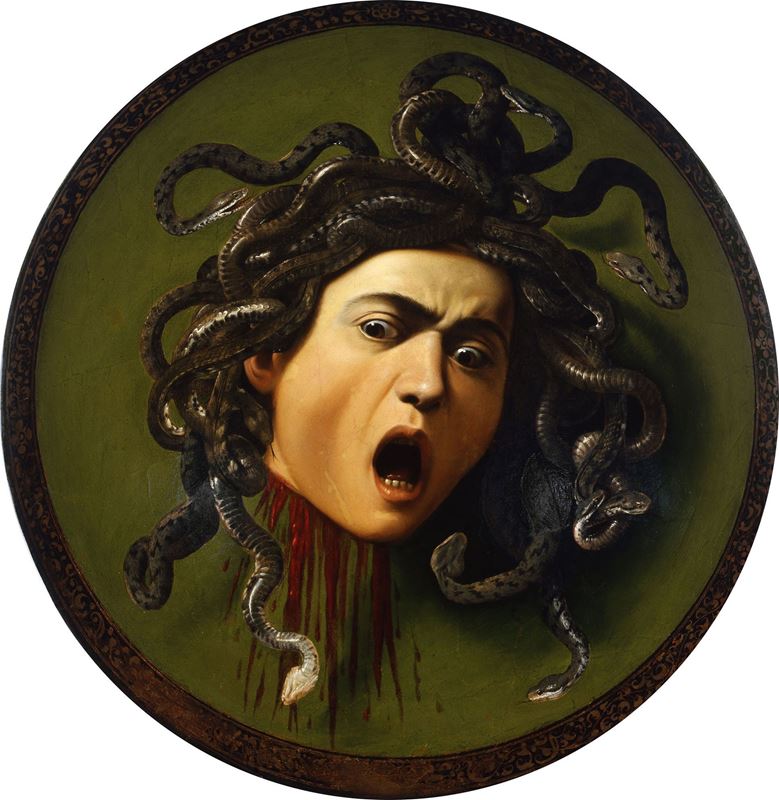Medusa's Story - Caravaggio
Medusa, 1598, Oil on canvas, Diameter 58 cm, Uffizi Gallery, Florence, Italy.
Medusa was one of three sisters in Greek mythology known as the Gorgos. Her difference between her two sisters, Sthenno and Euryale, was that she was mortal. The main characteristic of these creatures, whose hair was woven with snakes, with wild pig teeth, bronze hands and golden wings, was to release fear. They were turning the one they looked into stone. The most known and legendary monster girl was Medusa. One of the famous mythological stories about her was his adventure with Perseus:
Akrisios, the King of Argos, has a daughter named Danae. An oracle tells Akrisios that his daughter is going to have a baby, but that his grandson is going to kill him. Akrisios closes his daughter Danae in a room covered with bronze. Zeus comes as a golden rain through the ceiling hole. They combine with Danae and Perseus is born. Akrisios throws his daughter with his grandchild to the sea closing into a chest.
With the help of Zeus, the mother and son go to the island of Seriphos. King Polydektes's brother finds them. Perseus grows. But King Polydektes falls in love with Danae and wants to eliminate Perseus, who thinks that he will stop him. He orders him to bring the head of Gorgo Medusa.
Hermes and Athena appear to him to help Perseus. On the advice of these two gods, Perseus first went to the Graia near, the three old woman who protected the land of the Gorgos. These old women have single eyes and single teeth, which they use sequentially and jointly. They also know the location of the nymphs hiding three talismans to lead Perseus to success. Perseus takes the eyes of the Graia and their only teeth, as hostage to show him the way. When older women fulfill their condition, they get their limbs.
When Perseus arrives at the nymphs, he receives three charmed items from them: winged sandals, a magical saddlebag and a hat that makes Hades invisible to the wearer. Hermes also gives a very sharp steel sickle. Athena presents a shield from bronze. So Perseus sets off with his weapons and finds three Gorgo asleep.
He is lifted by winged sandals. He avoids eye contact with Medusa. He sees the image of the "Medusa" in the bronze shield that was the mirror that Athena had kept. So, he beheads the sleeping Medusa with Hermes's sickle. From the flowing blood, the winged horse Pegasos and Khrysaor are born. Perseus puts Medusa's head on the magical saddlebag and flies away. He gets rid of the other two Gorgo by wearing his invisibility hat.
Perseus's return to Seriphos was the salvation of Danae. Polydektes was disturbing Danae. Perseus shows the head of Medusa and turns Polydektes and his friends to stone.
After Perseus' victory, Medusa's head becomes the ornament of Athena. In her depictions he is usually fully armed, with a helmet on her head; the head of the Medusa in the middle of the shield in her left hand; again in the armor on her chest is found the head of Medusa.
In Caravaggio's work Medusa's cut head appears. Perseus used Athena's shield as a mirror not to see the face of Medusa and not to turn into stone. Thus, Perseus managed to cut off Medusa's head. The Medusa of Caravaggio is reflected image in the shield of Perseus. Painter uses a convex surface. He wants to make them feel that the ones who see the pictures really see the face of Medusa being reflected on the shield.
Caravaggio did not prefer the atmosphere in his table. The focal point in the painting was the cut head of Medusa, who was smeared in blood, surprised by her own death, and still alive. The painter described Medusa's snake-shaped hair as curling and moving. He reflected Medusa's short moment between life and death by a fearful and confused face.
Bibliography;
Erdoğan, C.E., (2015). Sanatın Büyük Ustaları Caravaggio, Birinci Baskı, Hayalperest Yayınevi, İstanbul.
Howard, A., (2017). İşte Caravaggio, Birinci Baskı, Hep Kitap, İstanbul.
Cömert, B., (1999). Mitoloji ve İkonografi, Birinci Baskı, Ayraç Yayınevi, Ankara.
Erhat, A., (2001). Mitoloji Sözlüğü, Onuncu Baskı, Remzi Kitabevi, İstanbul.
Der: Bonnefoy, Y., (2000). Mitolojiler Sözlüğü, Cilt II, Birinci Baskı, Dost Kitabevi, Ankara.













